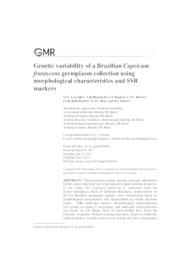Genetic variability of a Brazilian Capsicum frutescens germplasm collection using morphological characteristics and SSR markers.
Genetic variability of a Brazilian Capsicum frutescens germplasm collection using morphological characteristics and SSR markers.
Autoria: CARVALHO, S. I. C.; BIANCHETTI, L. B.; RAGASSI, C. F.; RIBEIRO, C. S. C.; REIFSCHNEIDER, F. J. B.; BUSO, G. S. C.; FALEIRO, F. G.
Resumo: Characterization studies provide essential information for the conservation and use of germplasm in plant breeding programs. In this study, 103 Capsicum frutescens L. accessions from the Active Germplasm Bank of Embrapa Hortaliças, representative of all five Brazilian geographic regions, were characterized based on morphological characteristics and microsatellite (or simple sequence repeat - SSR) molecular markers. Morphological characterization was carried out using 57 descriptors, and molecular characterization was based on 239 alleles from 24 microsatellite loci. From the estimates of genetic distances among accessions, based on molecular characterization, a cluster analysis was carried out, and a dendrogram was established. Correlations between morphological and molecular variables were also estimated. Twelve morphological descriptors were monomorphic for the set of C. frutescens accessions, and those with the highest degree of polymorphism were stem length (14.0 to 62.0 cm), stem diameter (1.0 to 4.2 cm), days to flowering (90 to 129), days to fruiting (100 to 140), fruit weight (0.1 to 1.4 g), fruit length (0.6 to 4.6 cm), and fruit wall thickness (0.25 to 1.5 mm). The polymorphism information content for the SSR loci varied from 0.36 (EPMS 417) to 0.75 (CA49), with an overall mean of 0.57. The correlation value between morphological and molecular characterization data was 0.6604, which was statistically significant. Fourteen accessions were described as belonging to the morphological type tabasco, 85 were described as malagueta, and four were malaguetinha, a morphological type confirmed in this study. The typical morphological pattern of malagueta was described. Six similarity groups were established for C. frutescens based on the dendrogram and are discussed individually. The genetic variability analyzed in the study highlights the importance of characterizing genetic resources available for the development of new C. frutescens cultivars with the potential for various niche markets.
Ano de publicação: 2017
Tipo de publicação: Artigo de periódico
Unidade: Embrapa Hortaliças
Observações
1 - Por padrão são exibidas publicações dos últimos 20 anos. Para encontrar publicações mais antigas, configure o filtro ano de publicação, colocando o ano a partir do qual você deseja encontrar publicações. O filtro está na coluna da esquerda na busca acima.
2 - Para ler algumas publicações da Embrapa (apenas as que estão em formato ePub), é necessário ter, no celular ou computador, um desses softwares gratuitos. Sistemas Android: Google Play Livros; IOS: iBooks; Windows e Linux: software Calibre.
Acesse outras publicações
Acesse a Base de Dados da Pesquisa Agropecuária (BDPA) para consultar o acervo completo das bibliotecas da Embrapa.

